What’s wrong with land-based offsets?
The important Land Gap Report gives a definitive, quantitative ‘no’ to reliance on land-based offsets given that offsets:
- take up too much land – Cumulative land-based solutions would add up to 1,200 million hectares globally. This is 50% more than Australia’s land mass, nearly as much as all agricultural land. These land-based offsets would risk greatly impacting the global food supply.
- are not equivalent (would have very little impact on reducing global temperatures)
- are too slow and have mismatched time of effect, including:
a) delay, due to trees and forests taking time to mature
b) replacing millennial natural storage (original forests) with 25 to 125 year storage that is critically inferior and lacking intrinsic resilience i.e. vulnerable to pests, drought and fire.
“My final point, my conclusion slide is tree planting is not a climate solution. It’s not a climate mitigation solution, like to mitigate climate change, to hold warming to 1.5 or two degrees. We need to reduce fossil fuel emissions to zero.”
Dr Kate Dooley
The Land Gap Report Presentation and Slideset
You can watch lead author Dr Kate Dooley’s full presentation here, and download her slideset here.
Real reductions are needed
A recent authoritative climate and land report, The Land Gap Report, gives the strongest support to the need for real reductions in emissions instead of land-based offsets.
The lead author, Dr Kate Dooley, in a presentation on Wednesday 22 March, highlighted the following points from her prior research, and from the Land Gap Report:
- Global warming is driven by cumulative emissions from long-term fossil stores (i.e. sequestered for millennia)
- There is no equivalency between emitting long-term fossil fuels, and land-based sequestration with respect to the fast-acting carbon cycle between the atmosphere, water and forests. Once long term carbon is emitted, it enters the fast acting carbon cycle permanently.
- Forest sequestration has a delay which majorly impacts any equivalence.
- Forest sequestration may well not be permanent – certainly, 25 years is not a scientifically based endpoint
- Land use change majorly affects biodiversity which greatly reduces the ability of the land to hold carbon. Poorly constituted offsets such as monoculture forests lack biodiversity, are vulnerable to pests and fire, and do not retain carbon well compared to primary (original) multi-species highly diverse forests.
- The Land Gap Report converted National Disclosure Commitments (NDCs) over time into hectares required for land sequestration and found that this sequestration would require 1200 million hectares, around 3.5 x India or 50% more than Australia’s land area, and will impact the food-bearing capacity of the planet
- Current agriculture uses 1,500 million hectares, well above the planetary boundary of 1,300 million hectares
- Even the best types of managed land-based sequestration (forest regeneration) at scale will have a very limited impact on global temperature, only contributing 0.1°C by the year 2100 – land-based sequestration is not a mitigation strategy, though some regeneration may be good for adaptation.
- Australia’s NDC of 43% by 2030 is not only not science-based (would need 75-80%) but it has a large proportion of land-based offsets, particularly involving land use change with adverse biodiversity impacts
The Land Gap Report recommendations (Slide 18)
- Prioritize the decarbonization of the global economy, via fossil fuel phase-out
- Protect and restore the world’s lands and forests – supporting the rights of Indigenous Peoples and local communities who are best placed to achieve these goals
- Separate targets between emission reductions and emissions removals to maintain the integrity of net zero pledges
- Tree planting is not a climate strategy!

The Land Gap Report highlights the needs for real reductions in fossil fuel emissions, because land based sequestration is neither equivalent or effective for climate mitigation
Comments on the Safeguard Mechanism (Slide 17)
The introduction of declining emissions baselines for Australia’s major emitters, under the existing Safeguard Mechanism, must be legislated so the following three (3) critical issues are addressed, with our reactions in bold:
- Unlimited offsets = no absolute cap on emissions. AVOID unlimited offsets
- Offsetting permanent fossil emissions with temporary removals into land and forests = no climate integrity. AVOID reliance on land and forest as major elements of the Safeguard Mechanism
- Allowing new fossil fuel projects into the scheme = government policies that do not address fossil fuel expansion. AVOID new gas and new coal (catastrophic Scope 3 emissions when burnt)
Unless these loopholes and issues are addressed, the proposed reforms to the Safeguard Mechanism risk increasing emissions in Australia and elsewhere and locking in dependence on fossil fuels.
The Land Gap Report presentation with chapter point links
Here is a summary of the major points of Dr Dooley’s presentation on March 22 with blue links to the relevant chapters in the full presentation video.
Ray Peck, Lighter Footprints Committee member, introduced Dr Kate Dooley, lead author of the Land Gap Report. Dr Kate Dooley is a Research Fellow at Melbourne University’s Climate & Energy College. Kate has policy expertise on forest governance, climate change and carbon accounting and has almost two decades experience advising government and non-government organisations.
Dr Dooley introduced her presentation which is split into three section a) science basis b) Land Gap Report c) policy recommendations and spoke to the urgency of the recent IPCC AR6 Summary Report – a last chance warning for humanity re trying to stay below 1.5°C warming from the world’s climate scientists.
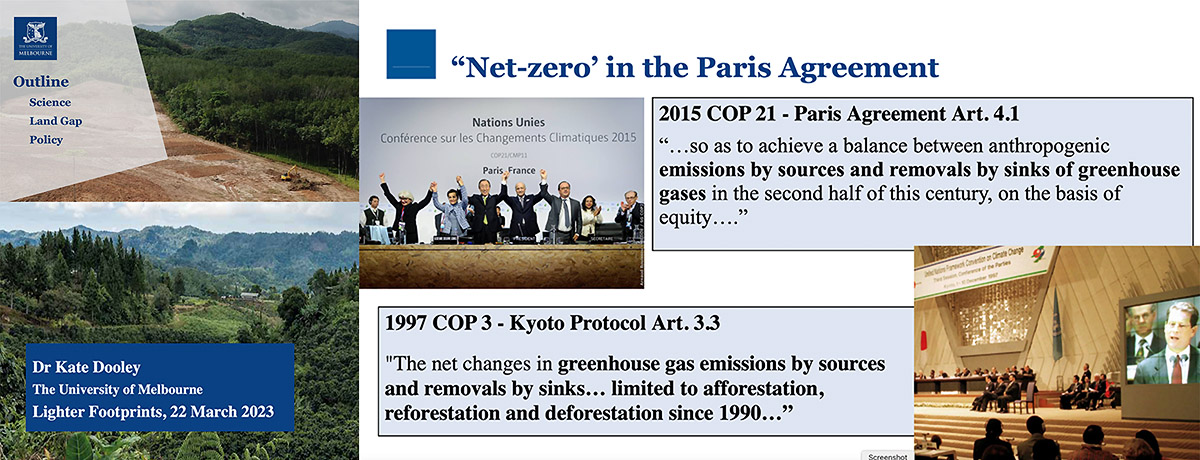
Dr Dooley spoke about her PhD research into the difference in the aims and methodology of the Paris Agreement and the Kyoto Protocol
A) Science Background
Analysis of difference between Paris Agreement & Kyoto
Dr Dooley spoke about her PhD research which examined the goals and framing of the Paris Agreement, and compared it to the Kyoto Protoco..
The Paris Agreement only seeks to balance sources and sinks without limits on sinks, whereas the Kyoto Protocol sought to lower emissions and the use of sinks was only an 11th hour agreement, vociferously opposed, and was limited.
“The Paris Agreement … puts these sinks into the centre of the main objective.
In the Kyoto Protocol.. the sinks are limited to afforestation reforestation since 1990.
In the main objective of the Paris Agreement, no limit, no limits, no rulebook, very, very concerning.”
Dr Kate Dooley
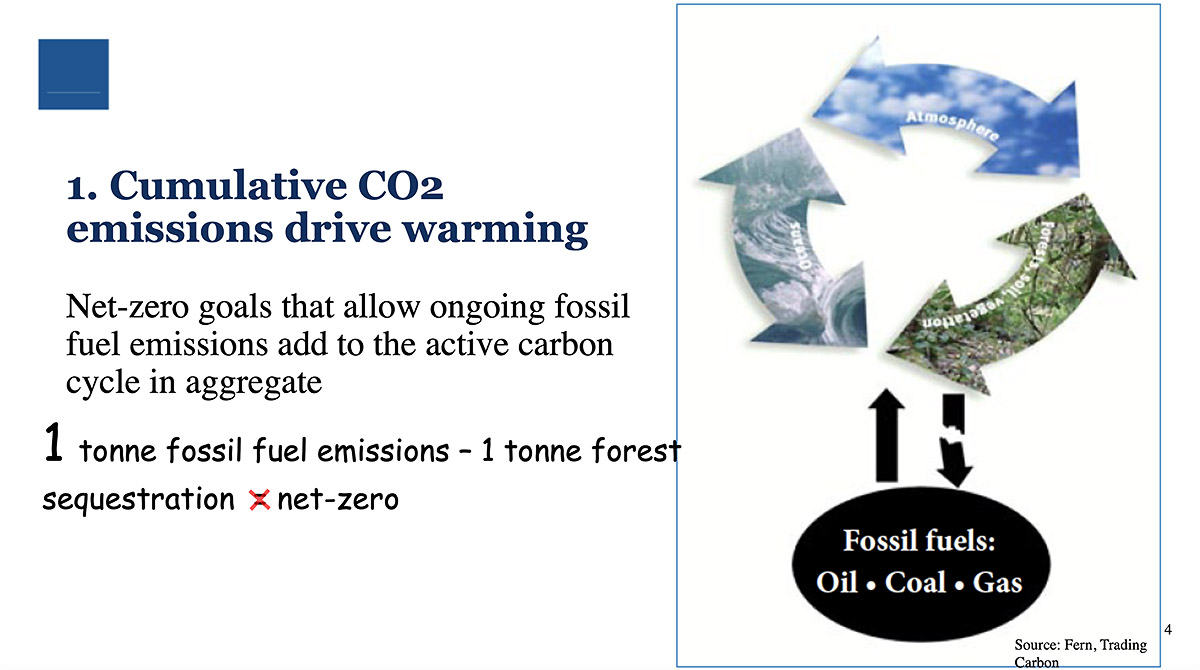
A key reason why fossil fuel emissions can’t be balanced by removing CO2 into trees is that this carbon will in short order be released back into the fast carbon cycle
Why sources and sinks don’t balance and are not equivalent
Cumulative emissions are what drive warming. Trying to balance long term carbon sources (oil, coal, gas) with active carbon sinks doesn’t work, as long term carbon permanently enters the active carbon cycle and will return to the atmosphere in a relatively short time scale.
“If you move carbon from permanently locked away fossil fuels, put it in the atmosphere and then pull it into trees, it’s not permanently locked away. There is more carbon in that carbon cycle and it will move from the trees and land back into the atmosphere in short timescales.”
Dr Kate Dooley
Global CO2 illustrative model pathways.
Delay in acting (P2, P3, P4 pathways) requires ever faster removals once action is started. Unfortunately forests offsets have an inbuilt delay as trees mature. The pathways with most delay, P3, P4, carry a high risk for global food supply.

The longer the delay, the more risk of overshoot balanced by land-based offsets which will use up a large amount of land
Land based CO2 removal drives biodiversity loss
Examining land use changes -Dr Dooley talked us through the graph above from research that looked at the massive scale of land has been committed for energy crops under different scenarios. This large commitment of land will have adverse effects due to biodiversity losses. Land use changes resulting in monoculture crops, especially with the most delayed P4 pathway, will have large biodiversity impacts, due to the biggest overshoot and reliance on land based sequestration.
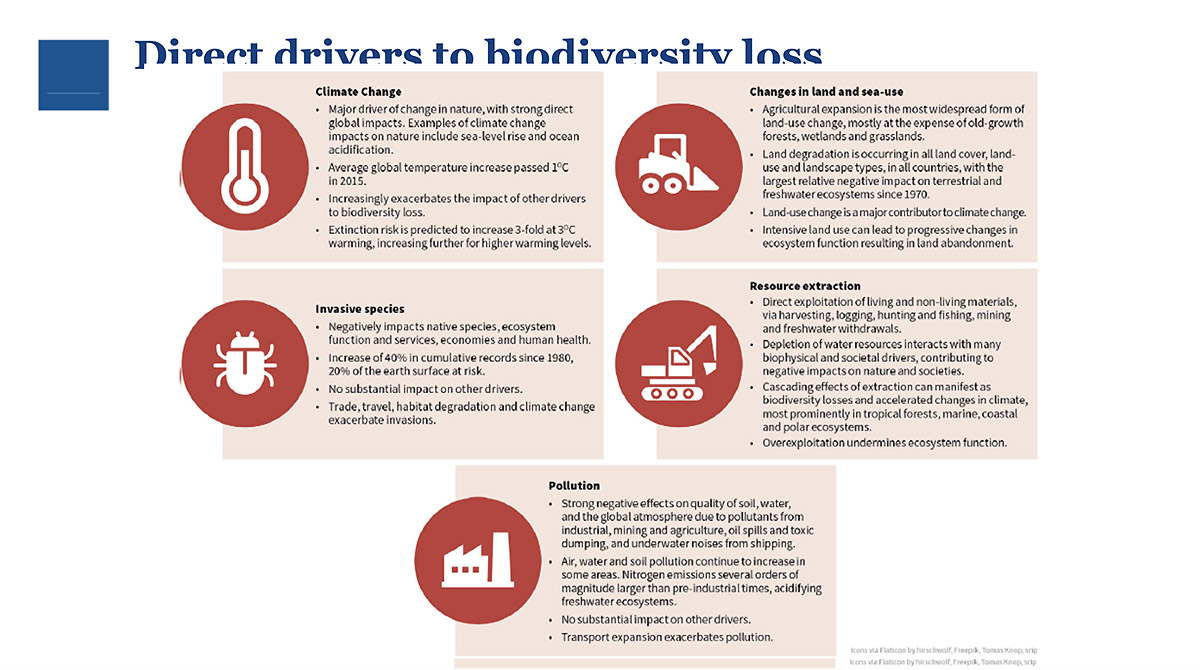
Of direct drivers, land use change is the biggest driver of biodiversity loss
Direct drivers to biodiversity loss
Land use change is the worst direct driver of biodiversity loss of the five drivers noted in the slide above. Dr Dooley noted that with a high reliance on land based sequestration, we’re proposing massive land use changes, especially with P4. CO2 removal drives biodiversity loss. P2 best of the bad pathways – but there is still considerable biodiversity loss.

Using land based dequestration immpacts biodiversity. Very good regenerative sequestration has little impact on temperature
Even the very best land based approaches will not lower temperature effectively
Dr Dooley spoke about research that examined climate benefits from land-based CO2 removal which found that even with very best regenerative approachn used en masse, a land based approach will only offer a very small 0.01°C temperature reduction shift by 2100.
B) Land Gap Report
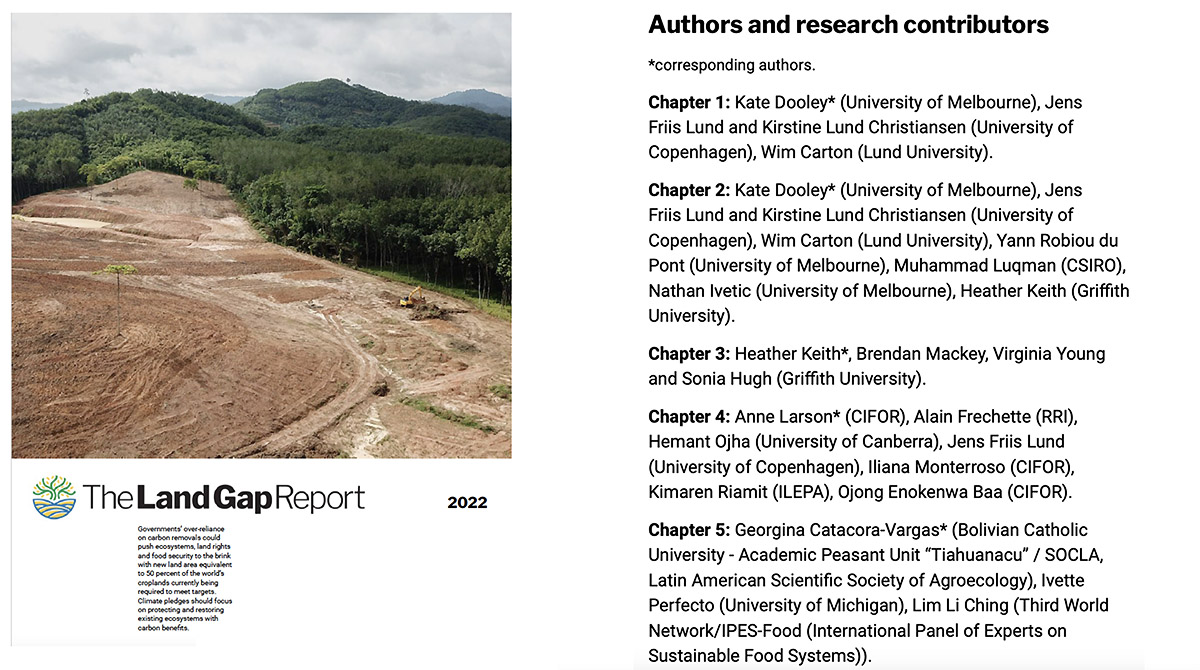
The Land Gap Report quantified the land use from national Paris pledges and qualitively about various approaches
Land Gap Report outline
Land Gap Report has 20 expert authors. It assessed how much land was in various countries Paris pledges, a first. The Report found that too much land would be required for these pledges, and land based approaches would impact people, agriculture and food security.
“More than half of the total area pledged involves land use change, which puts more pressure on ecosystems, food security and indigenous people’s rights”
Dr Kate Dooley
Results
The Report finds that land based pledges total 1.2 billion hectares, that is 3.5x Indias! Over half of these pledges require damaging land use change, including in Australia.
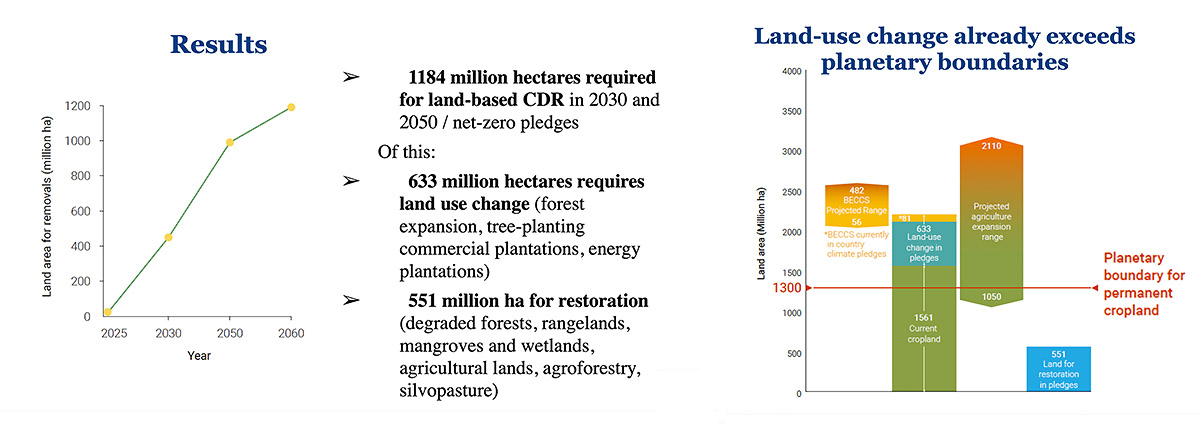
1200 million hectares would be need for all countries Paris pledges, nearly as much as all agricultural land, more than half with land use changes
Land used commitments and planetary boundaries
Land-use change already exceeds the planetary boundary for cropland (we have to thank climate scientist Will Steffen (ANU) for developing this). Agriculture at 1500 m hectares has exceeded planetary boundary (1300 m hectares). Land based pledges would take us even further past (2200 m hectares).
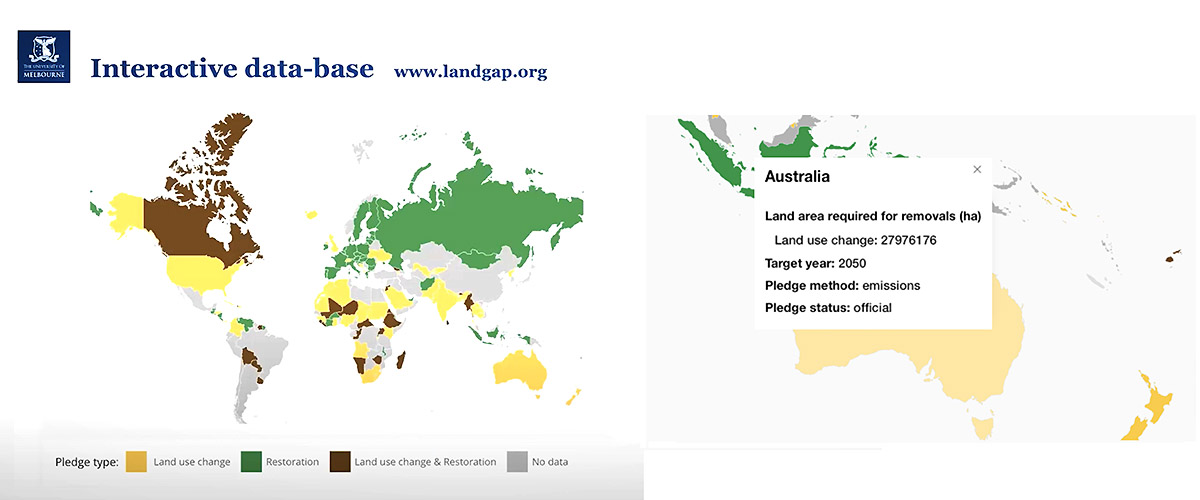
The Land Gap Report has an interactive map recalling each countries pledges and whether they are restorative (green) or requiring land use changes (orange)
Interactive map based on countries land based pledges and their type
The Report contains ab interactive map looking at national pledges and their impacts on land use.
Green: restoration, orange: land use change – Australia is coloured orange due to our high reliance on land use change (ie tree planting instead of restoration).
Although Australia’s NDC only commits 27 million hectares, that would be around a third of our rather small agricultural usage of 75 million hectares.
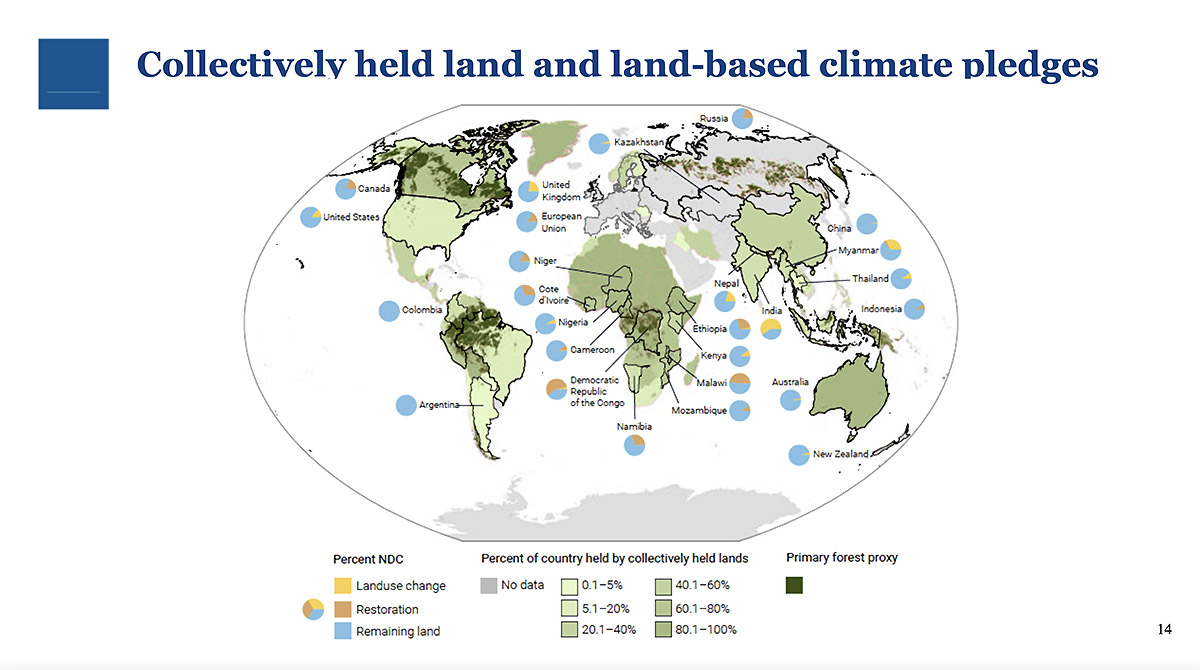
The dark green areas are primary forest, and lighter greens reflect the collective or indigenous land tenure
Collectively held land and land-based climate pledges
Dark green is primary forests (only a few tiny dots in Australia) and shades of green – collectively held lands/indigenous held lands. The chapter examines carbon performance and finds that collectively held or indigenous lands out perform in markers such as biodiversity and carbon sequestration.
Land Gap Report Key Messages
Countries’ climate pledges rely on unrealistic amounts of land-based carbon removal, especially land use change with pressure on biodiversity, food, land rights.
Recommendations include an immediate reduction of fossil fuel use and a rapid transition to clean energy, granting land rights, increasing agroecology and land restoration, and avoiding land use change such as planting monocultures.
C) Policy Discussions
Australia’s Paris commitments
Australia’s NDC had not been updated since 2014, but new commitment at 43% by 2030 still grossly inadequate and relies on land based offsets in Safeguard Mechanism
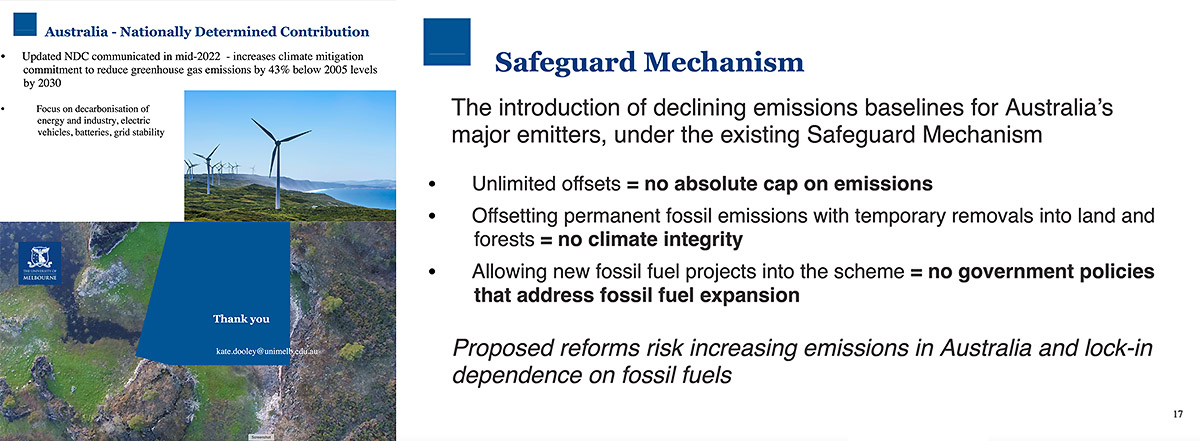
Australia’s revised pledge of 43% reductions by 2030 is woefully inadequate, and although focussing on energy systems still relies on land based offsets with major biodiversity consequences
- Currently the Safeguard Mechanism has no cap and has unlimited offsets.
- Offsetting permanent fossil emissions with temporary land based offsets is not scientifically accurate – it will not work.
- The Safeguard Mechanism allows new fossil projects into the system.
- IPCC AR6 Synthesis report clearly says no more fossil developements.
- No new coal and gas is in line with the AR6 – last warning from world’s scientists.
Land Gap Report Recommendations
Recommendations
- Fossil fuel phase out.
- Enhance forest protection, restoration, land rights.
- Better accounting of actual emissions reduction to maintain integrity.
- Tree planting is not climate strategy!
Audience Questions
Question One on fossil industry approach, and Question Two on land needed for agricultural progress
The fossil fuel industry want offsetting CCS rather than real reductions.
Is there land for land use to offset its own land use change? Yes plenty, especially if it is agricultural rather than fossil emissions.
“If you’re only offsetting biological emissions, then there’s a lot less to offset and therefore the land is available and you don’t have this this temporal problem of offsetting carbon that has been stored away for millennia with temporary forest because those biological emissions are also on short timescales.”
Dr Kate Dooley
Question 3 What about the CSIRO report on land based carbon removal?
The CSIRO report was based on an economic model, ignores shifts in food production, and overstates the carbon in monoculture forests.
“The Australian Government uses economic modelling. So they’re based on a carbon price point where carbon might out value the carbon sequestration into trees, could out value other uses of land. So I think that’s a very problematic way to look at it”
Dr Kate Dooley
Question 4 What about water usage?
Although the Land Gap Report didn’t formally look at water usage, it recommends forest restoration over land use change with monocultures, where nutrients including water have to be added to the system.
“So you could have a monoculture plantation. There’s no ecosystem integrity, it’s very degraded. But the carbon still in the trees, because they’re standing there, the carbon might be lost out in the soils, but they’re also far less resilient to stress and to external stress. So heatwaves, drought, insects, attack, that sort of thing. Monoculture plantations are very, very susceptible.”
Dr Kate Dooley
Question 5 Disadvantages of monocultures
Monocultures are much less resistant to fire and pests.
“We need to think about ecosystem integrity when thinking about carbon in land or forests because it’s ecosystem integrity based on biodiversity that maintains or allows the carbon to stay in that land or forests. So as you degrade an ecosystem, you lose carbon.”
Dr Kate Dooley
Question 6 What about land use for solar?
Land use for solar and renewables are orders of magnitudes less than that required for agriculture or land based offsetting.
“There’s a couple of studies that look globally at this. They model out a transition to a 100% renewables globally and how much land that would take. It’s orders of magnitude less. So there is not a concern with renewables taking out land that we don’t have.”
Dr Kate Dooley
Question 7 Discussion of agricultural approaches such as agroforestry
Q7 Under-utilised agricultural land? Sweet spot for agro-forestry, indigenous use?
Agroforestry is a useful adaptation solution, not mitigation.
“Agroforestry is a really good example of the right tree in the right place because it’s integrating trees into farmlands, which is how agriculture was done.”
Dr Kate Dooley
Question 8 Have any governments challenged the Land Gap Report?
Not at this stage
Question 9 Chubb report on the ACCUs
A range of commentators have expressed disappointment about the Chubb Report, for examining the method rather than examine individual projects. Dr Dooley noted the ANU research which finds that poor integrity projects may still constitute 40% of ACCUs.
“The review came out with no major recommendations to change anything. So while the Chubb Review has recommended some changes to those methodologies, existing projects will continue using those flawed methodologies for years.”
Dr Kate Dooley
Question 10 Do politicians understand the problems with offsets?
Politicians appear to be confused about issues around offsets and land based sequestration, and Dr Dooley says this is an upcoming area of further research.
Question 11 Discussion about the chapter on common tenure, land rights and carbon
Indigenous land rights/tenure out perform private or government tenure.
“I do recommend reading that chapter because it’s a review of of literature on this topic from really the last decade or two. And it’s put together by a team of authors who are very, very highly specialised in that area.”
Dr Kate Dooley
Question 12 What about Australia?
Restore degraded ecosystems. Hundreds of years to get back to primary forest.
1) Protect
2) Restore
3) Sustainable management of only plantation forest
Question 13 What about biodiversity offsets?
Australia has lost so much of its primary forest – nothing left to offset

